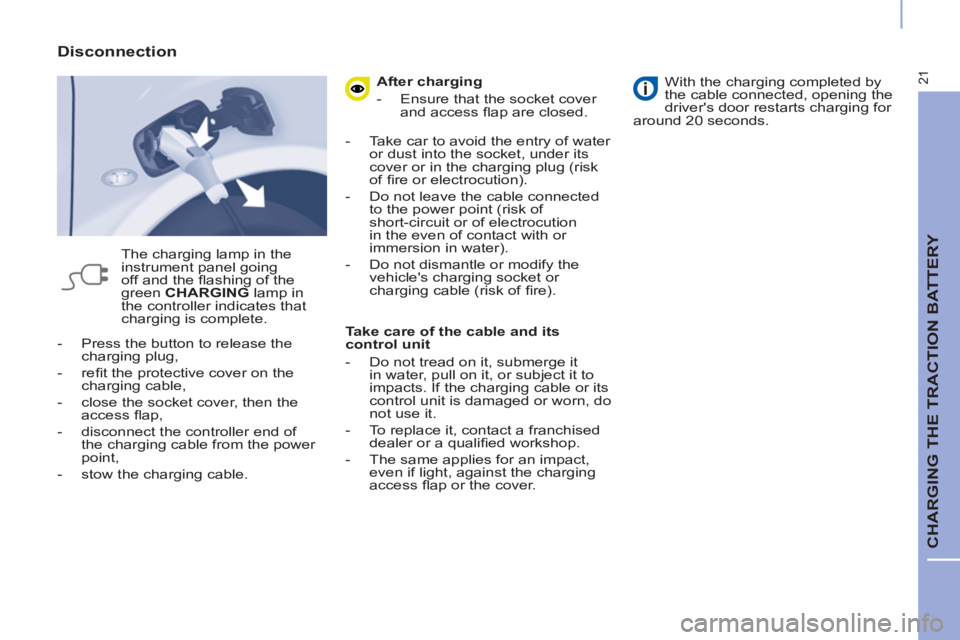Page 308 of 328

14
MANUAL AIR CONDITIONING AND HEATING
ECO
(stops the air conditioning
and heating).
OFF
(stops the heating, air
conditioning and ventilation).
Windscreen demist.
Rear screen demist on
versions with glazed rear
doors.
Air distribution.
Recirculation of interior air/
Intake of exterior air.
Increase/Reduce air fl ow.
Increase/Reduce temperature.
Ventilation can be used as
soon as this indicator is on.
After a prolonged period without
use of the heating system, its
operation may result in a slight
odour during the fi rst few minutes
of use.
Special features of the air
conditioning and heating
The air conditioning and heating
systems do not regulate the
temperature in the cabin directly, but
ensure a constant temperature at the
fan-fed air vents (a temperature which
is indexed to the level of hot or cold
desired by the users).
if you want to rapidly heat or cool the
vehicle cabin, you can temporarily set
the temperature control to maximum
hot or cold.
It should be noted however that:
- The air conditioning system
(cooling of the air) only operates
when the ambient temperature is
above 15°C,
- The power of the heating system
is progressively restricted when
the ambient temperature is above
20°C.
Manual heating version
Practical advice
Heating and ventilation
In winter, air distribution
towards the footwells is
recommended, allowing a
more uniform ambience to be
obtained in the cabin.
In summer, distribution towards the
face-level vents will increase the
effectiveness of the ventilation and air
conditioning.
In heating mode, try to use
moderate level of ventilation,
that is less than 3 blades. This
will allow the system to deliver
air at a higher temperature.
Air distribution
Page 315 of 328

21
CHARGING THE TRACTION BATTERY
- Press the button to release the
charging plug,
- refi t the protective cover on the
charging cable,
- close the socket cover, then the
access fl ap,
- disconnect the controller end of
the charging cable from the power
point,
- stow the charging cable.
Disconnection
The charging lamp in the
instrument panel going
off and the fl ashing of the
green CHARGING
lamp in
the controller indicates that
charging is complete.
After charging
- Ensure that the socket cover
and access fl ap are closed.
- Take car to avoid the entry of water
or dust into the socket, under its
cover or in the charging plug (risk
of fi re or electrocution).
- Do not leave the cable connected
to the power point (risk of
short-circuit or of electrocution
in the even of contact with or
immersion in water).
- Do not dismantle or modify the
vehicle's charging socket or
charging cable (risk of fi re).
Take care of the cable and its
control unit
- Do not tread on it, submerge it
in water, pull on it, or subject it to
impacts. If the charging cable or its
control unit is damaged or worn, do
not use it.
- To replace it, contact a franchised
dealer or a qualifi ed workshop.
- The same applies for an impact,
even if light, against the charging
access fl ap or the cover.
With the charging completed by
the cable connected, opening the
driver's door restarts charging for
around 20 seconds.
Page 324 of 328
30
TOWING THE VEHICLE
Front towing eye
The rear towing eye must not be used
for towing on the road. It can be used
to extract the vehicle when stuck, for
example. The towing eye is stowed in the tool
box under the right hand seat.
Towing the vehicle with the driving
wheels on the ground is prohibited.
When towing the vehicle with just two
wheels on the ground, use professional
lifting equipment.
Failure to do this may cause damage
to the braking components and the
electric motor.
Rear towing eye
Towing another
vehicle
Your vehicle cannot in any
circumstances be used to tow another
vehicle.